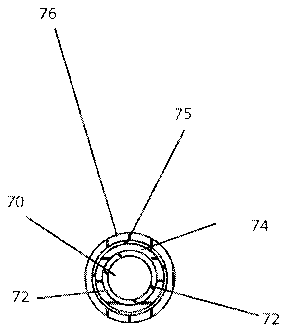Some of the information on this Web page has been provided by external sources. The Government of Canada is not responsible for the accuracy, reliability or currency of the information supplied by external sources. Users wishing to rely upon this information should consult directly with the source of the information. Content provided by external sources is not subject to official languages, privacy and accessibility requirements.
Any discrepancies in the text and image of the Claims and Abstract are due to differing posting times. Text of the Claims and Abstract are posted:
| (12) Patent: | (11) CA 2587801 |
|---|---|
| (54) English Title: | CABLES |
| (54) French Title: | CABLES |
| Status: | Expired and beyond the Period of Reversal |
| (51) International Patent Classification (IPC): |
|
|---|---|
| (72) Inventors : |
|
| (73) Owners : |
|
| (71) Applicants : |
|
| (74) Agent: | GOWLING WLG (CANADA) LLP |
| (74) Associate agent: | |
| (45) Issued: | 2013-11-05 |
| (86) PCT Filing Date: | 2005-12-01 |
| (87) Open to Public Inspection: | 2006-06-08 |
| Examination requested: | 2010-12-01 |
| Availability of licence: | N/A |
| Dedicated to the Public: | N/A |
| (25) Language of filing: | English |
| Patent Cooperation Treaty (PCT): | Yes |
|---|---|
| (86) PCT Filing Number: | PCT/GB2005/050225 |
| (87) International Publication Number: | WO 2006059157 |
| (85) National Entry: | 2007-05-10 |
| (30) Application Priority Data: | ||||||
|---|---|---|---|---|---|---|
|
A cable for suspended disposition in a borehole or the like for supplying
electrical power, has a conducting member which is part of the load bearing
system, or even carries the majority of the tensile stress on the cable. The
conducting member comprises copper-clad steel or beryllium-copper alloy. The
conducting member may include two or more separate electrically insulated
conductors.
L'invention décrit un câble destiné à être placé en suspension dans un trou de sonde ou analogue pour fournir de l'énergie électrique, lequel comprend un élément conducteur qui fait partie du système porteur, voire même qui porte la plus grande partie de la contrainte de traction sur le câble. L'élément conducteur comprend de l'acier recouvert de cuivre ou un alliage de cuivre et béryllium. L'élément conducteur peut comprendre au moins deux conducteurs séparés isolés électriquement.
Note: Claims are shown in the official language in which they were submitted.
Note: Descriptions are shown in the official language in which they were submitted.

2024-08-01:As part of the Next Generation Patents (NGP) transition, the Canadian Patents Database (CPD) now contains a more detailed Event History, which replicates the Event Log of our new back-office solution.
Please note that "Inactive:" events refers to events no longer in use in our new back-office solution.
For a clearer understanding of the status of the application/patent presented on this page, the site Disclaimer , as well as the definitions for Patent , Event History , Maintenance Fee and Payment History should be consulted.
| Description | Date |
|---|---|
| Time Limit for Reversal Expired | 2016-12-01 |
| Letter Sent | 2015-12-01 |
| Grant by Issuance | 2013-11-05 |
| Inactive: Cover page published | 2013-11-04 |
| Inactive: Final fee received | 2013-08-23 |
| Pre-grant | 2013-08-23 |
| Notice of Allowance is Issued | 2013-03-05 |
| Letter Sent | 2013-03-05 |
| Notice of Allowance is Issued | 2013-03-05 |
| Inactive: Approved for allowance (AFA) | 2013-02-28 |
| Amendment Received - Voluntary Amendment | 2012-10-26 |
| Inactive: S.30(2) Rules - Examiner requisition | 2012-05-01 |
| Letter Sent | 2010-12-10 |
| Request for Examination Requirements Determined Compliant | 2010-12-01 |
| All Requirements for Examination Determined Compliant | 2010-12-01 |
| Request for Examination Received | 2010-12-01 |
| Small Entity Declaration Determined Compliant | 2008-11-26 |
| Small Entity Declaration Request Received | 2008-11-26 |
| Inactive: Cover page published | 2007-08-07 |
| Inactive: Notice - National entry - No RFE | 2007-08-02 |
| Inactive: Inventor deleted | 2007-08-02 |
| Inactive: First IPC assigned | 2007-06-07 |
| Application Received - PCT | 2007-06-06 |
| National Entry Requirements Determined Compliant | 2007-05-10 |
| Small Entity Declaration Determined Compliant | 2007-05-10 |
| Application Published (Open to Public Inspection) | 2006-06-08 |
There is no abandonment history.
The last payment was received on 2012-11-23
Note : If the full payment has not been received on or before the date indicated, a further fee may be required which may be one of the following
Please refer to the CIPO Patent Fees web page to see all current fee amounts.
| Fee Type | Anniversary Year | Due Date | Paid Date |
|---|---|---|---|
| Basic national fee - small | 2007-05-10 | ||
| MF (application, 2nd anniv.) - small | 02 | 2007-12-03 | 2007-05-10 |
| MF (application, 3rd anniv.) - small | 03 | 2008-12-01 | 2008-11-27 |
| MF (application, 4th anniv.) - small | 04 | 2009-12-01 | 2009-11-26 |
| MF (application, 5th anniv.) - small | 05 | 2010-12-01 | 2010-11-26 |
| Request for examination - small | 2010-12-01 | ||
| MF (application, 6th anniv.) - small | 06 | 2011-12-01 | 2011-12-01 |
| MF (application, 7th anniv.) - small | 07 | 2012-12-03 | 2012-11-23 |
| Final fee - small | 2013-08-23 | ||
| MF (patent, 8th anniv.) - small | 2013-12-02 | 2013-11-18 | |
| MF (patent, 9th anniv.) - small | 2014-12-01 | 2014-11-26 |
Note: Records showing the ownership history in alphabetical order.
| Current Owners on Record |
|---|
| PHILIP HEAD |
| Past Owners on Record |
|---|
| None |